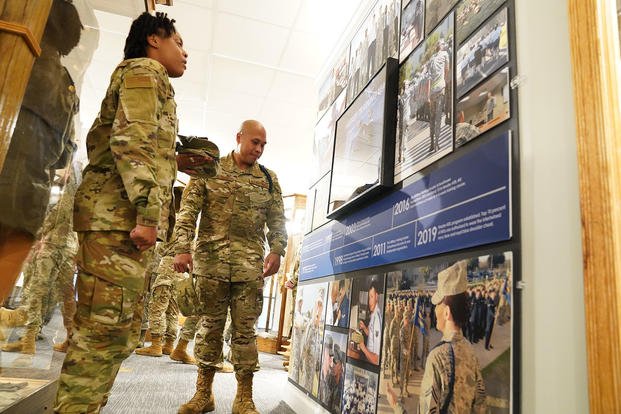MAXWELL AIR FORCE BASE, Ala. -- The women of today's Air Force can look back with pride to Staff Sgt. Esther McGowin Blake.
"We consider her the first lady of the Air Force," said William Chivalette, the curator of the Enlisted Heritage Hall at Gunter Annex here. "She raised her right hand to enlist in the U.S. Air Force on the first minute of the first hour of the first day, July 8, 1948, that women could join the United States Air Force, created nine months before on Sept. 17, 1947."
Less than a month before, on June 12, 1948, former President Harry S. Truman signed the Women's Armed Services Integration Act (Public Law 625-80), which authorized women to serve as regular members of the U.S. armed forces.
Born on July 7, 1897, in Escambia, Alabama, Blake served as a civilian employee of the Army Air Forces Air Service Command at the Miami Air Depot in Miami, now a part of the Miami International Airport, after World War II started.
In March 1944, she enlisted in the Women's Army Corps after the War Department notified her that her oldest son, 1st Lt. Julius Blake, a B-17 Flying Fortress pilot in England, had been shot down over Belgium and was reported missing. He remained "missing in action" for nine months.
Her younger son, 1st Lt. Thomas Blake, who flew a B-25 Mitchell bomber in Italy, later said that his mother joined the Women's Army Corps hoping to free a soldier from clerical work to fight, thus speeding the end of the war.
"If I can do this," Blake said, "my efforts will be worthwhile."
While Thomas also was shot down after 50 combat missions, Blake saw both of her sons return home by the end of the war with only minor wounds and many decorations.
During the war, Blake served at several bases throughout the U.S., including one year in Alaska near the Aleutians and in the Yukon territory. She separated from the Army in November 1945 and returned to her civil service job in Miami. However, heeding a recall for women in the military services, she reenlisted in the Army in April 1947. The Army assigned her to Fort McPherson near Atlanta.
The Air Force became a separate military service on Sept. 17, 1947. After the enactment of the Women's Armed Services Integration Act on June 12, 1948, the Air Force within a month established the Women in the Air Force as a separate organization to oversee the training and administration of WAF. At the time, Congress had limited the number of women in the Air Force to 300 officers and 4,000 enlisted members, assigned primarily to clerical and medical career fields. The Air Force inactivated the WAF in June 1976.
At the first available opportunity to return to her roots, Blake transferred from the Army to the Air Force on July 8, 1948, minutes after the start of the first duty day for the WAF, along with 11 other women at Fort McPherson. She remained on active duty with the Air Force until 1954, when she separated because of a disability and went to work as a civil servant at the Veterans Administration Regional Headquarters in Montgomery, Alabama.
Blake died on Oct. 17, 1979, at the age of 82, at the Veterans Hospital in Tuskegee, Alabama, among fellow veterans.
On Oct. 1, 1987, the Air Force named one of the student dormitories at the Air Force Senior NCO Academy at Gunter Annex in her honor.
"In singling out and recognizing in such a special way one of your own, you pay respect and tribute not only to Air Force Staff Sgt. Esther McGowin Blake, you honor all of us who knew and loved her and who were privileged to share her life," her son, Thomas, said at the dedication ceremony.
"It's never easy being the first. The trail that Esther Blake blazed made it possible for other women to follow," said Chief Master Sgt. Timothy Horn, the Air University command chief. "Her success opened the doors to allow future women the opportunity to serve with pride. Our Air Force is emphatically better for her efforts."
Today, women serve in all available career fields in the Air Force, including as security forces members and combat pilots.
"Staff Sgt. Blake's spirit of service to country and duty to the Air Force lives on in the women of today's Air Force," Chivalette said.
Interested in Joining the Military?
We can put you in touch with recruiters from the different military branches. Learn about the benefits of serving your country, paying for school, military career paths, and more: sign up now and hear from a recruiter near you.















